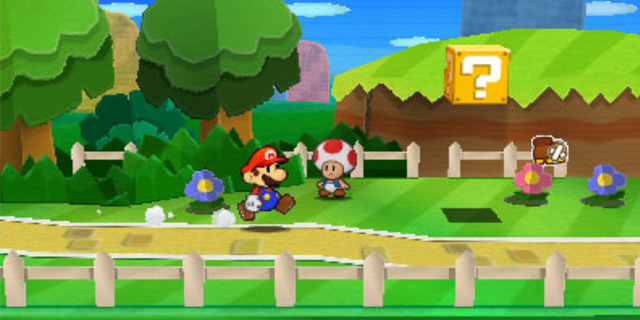
The Paper Mario series is one that’s taken an interesting path. The first two games were amazing RPGs, but then a pair of factors threw it in a different direction: the decreasing worldwide popularity of the genre, and the rise of the Mario & Luigi series. A franchise in exile with Super Paper Mario, it’s settled somewhere closer to home with this latest entry.
Just not close enough.
Paper Mario: Sticker Star sees the mustachioed plumber saving the day again, this time retrieving power-granting stickers from Bowser and his minions. Stickers are also now how Mario attacks: instead of having special moves and SP, you peel stickers you find, put them in your book and use them up when you want to, say, swing your hammer or jump. The items from the previous games are also stickers, like shells and mushrooms. There are worn-out, weaker stickers, powerful shiny ones and even big special ones.

Timing’s still important, as hitting the A button at the right time lets you deal more damage. The more varied commands from previous games aren’t really here, so it’s a bit more monotonous. The two things that really hold the combat back, though? Consumable stickers instead of refillable SP meters mean that you’ll do everything possible to avoid using great moves, and without the first two games’ sidekicks, it’s just you out there every time. So be prepared to just jump and use hammers on almost everything.
Also peculiar is the lack of true progression. When you collect more powerful stickers, you’re stronger in a way, but you don’t level up or gain experience. The only stat boost in the game is a pick-up you can find to increase your max HP by 5. This all means that random battles mean nothing. We avoided them whenever we could, because not only did it not make us stronger, but it used up stickers.
So what is this game, then? It feels closer to an adventure game than we’d anticipated. You walk around, trying to navigate through worlds and defeat enemies, but a lot of the hazards require you to “paperize” the world, making it flat so you can put stickers onto objects. You’ll add bridges over gaps, block wind from pipes and peel and re-stick objects in the proper orientation.

There are some touches in Sticker Star that were clearly included to make the game feel more like a Mario game. There’s an overworld map with individual level dots grouped into worlds, and there’s a castle at the end of each with a big boss to take down. This actually seems like a smart choice for the first portable installment, as it breaks up the action into five-to-ten-minute segments. It also allows you to go back and “grind,” finding particular stickers you need elsewhere or just collecting coins to buy super-powerful stickers at the shop in the centrally-located town.
There are also some nice collection aspects in the game. There’s a sticker museum where you can gather all the different stickers and stick them (manually, and yeah, that gets tedious) to the frames in the rooms. Occasionally you’ll come across a 3D object, which you can convert to a sticker and typically use to solve an environmental puzzle or open up a path. Still, though, you could also be using these in battle, and when you use them up, they’re a pain (or a hefty sum) to replace.
There are shades of the original games here, and the aesthetics are certainly as great as ever. The paper look works wonders in 3D, as you’d expect, and there are some great diorama-looking paths and rooms to walk around in. The tunes are consistently delightful, and while there’s not really as much to work with here as there’s been in more story-focused entries, the writing is still top-notch.
Mostly, though, Sticker Star brings out the worst obsessive tendencies you have, with its focus on the evanescence of one-use items. It doesn’t let you build up strength and feel like you’re making progress, and it does so with a past that managed to have none of these issues. It’s not a bad game, if your personality can handle its quirks, but if you want that ineffable delight that has come to define a Mario RPG, you may need to hold out for a new Mario & Luigi.
Pros: Great aesthetics and writing, portable-focused world structure
Cons: One-use items and related anxiety, lack of true progression



















